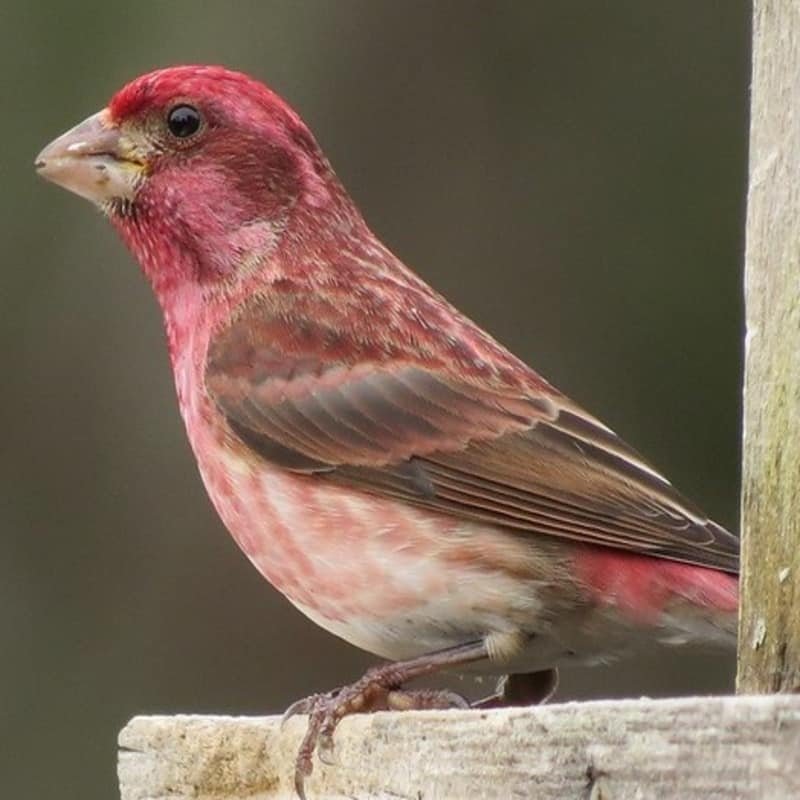The purple finch, Haemorhous purpureus is a Fringillidae finch. The three North American rosefinches are not closely related to the Old World rosefinches and have thus been moved to the genus Haemorhous by most taxonomic authorities. Its bill is conical, pointed, and well-adapted for cracking open seeds.
Quick Overview: Haemorhous Purpureus – Purple Finch
Body size: Around 5.5-6.25 in (14-16 cm) and a weight of 34 g (1.2 oz)
Main colors: Red, Brown, White
Range: Eastern United States
Migratory Bird: Yes
Best time of the year to see in the U.S.: January, February, December
Conservation Status: Least Concern
Purple finch Description
Its conical, pointed bill is ideal for cracking open seeds. rumps, throats, breasts, flanks, and rumps are all red. Brown with redwing and tail feathers. White belly and tail coverts Females’ heads are patterned in brown and white. Brown crowns with white supercillia. A brown patch runs from ear to ear. Dark brown malar and thick white mustache stripes. Whitethroats, brown streaks on breast, belly, and flanks. fem. white belly, undertail coverts They have two-tone brown backs. It has a deeply notched tail like many finches.

Size
These birds have a length of 5.5-6.25 in (14-16 cm) and a weight of 34 g (1.2 oz). Their wings could range from 9.25-10.5 in (23-27 cm).
Feeding
Carpodacus purpureus is a granivore that eats seeds. Diet changes seasonally to include abundant food sources like insects and fruits. This species prefers the seeds of fruits to the fleshy portions. In early spring, it eats tree buds and blossoms. The young eat mostly seeds. This species feeds on elm, tuliptree, maple, sweetgum, sycamores, ash, redcedar, juniper, and mountain ash. In addition to hackberries, Carpodacus purpureus feeds on grapes, poison ivy, strawberries, and blackberries.
Habitat
This species is found in both forest and urban areas. Breeding occurs in open coniferous or mixed coniferous-deciduous forests. A variety of breeding habitats are available in urban areas such as parks and orchards. Studies show that this species prefers forest patches with lots of edges. During the winter, Carpodacus purpureus is a habitat generalist, living in any area with enough food. Historically, this species thrived in urban parks, gardens, and streets lined with ornamental trees.
Behavior
Migratory species breed in southern Canada, New England, and the west coast of the US, then migrate south to overwinter in the east. This species is one of many that have eruptive winter ranges. Unlike most species, these species’ eruptions are caused by population growth unrelated to seed crop size. During the winter, Carpodacus purpureus forms flocks of 2 to over 200 birds of the same or different species. Interspecific groups include pine siskins and American goldfinches. During the winter, they feed and roost in conifers.
Haemorhous Purpureus Scientific Classification
- Kingdom: Animalia
- Phylum: Chordata
- Subphylum: Chelicerata
- Class: Aves
- Order: Passeriformes
- Family: Fringillidae
- Subfamily: Carduelinae
- Genus: Haemorhous
- Species: Haemorhous purpureus
Best time of the year to see
The best time to see these birds in the United States is during the winter season (December to February).
Distribution of the Purple finch in the USA
Breeds from southern Yukon to Newfoundland, southward through the western mountains to California, and east to West Virginia from eastern Minnesota. Winters in the south, near the US-Mexico border.
The Purple finch can be found in the following states in the United States – Alabama, Alaska, Arkansas, Connecticut, Delaware, Florida, Georgia, Hawaii, Illinois, Indiana, Iowa, Kansas, Kentucky, Louisiana, Maine, Maryland, Massachusetts, Michigan, Mississippi, Missouri, Nebraska, New Hampshire, New Jersey, New York, North Carolina, North Dakota, Ohio, Oklahoma, Oregon, Pennsylvania, Rhode Island, South Carolina, South Dakota, Tennessee, Vermont, Virginia, Washington, and Wisconsin.

